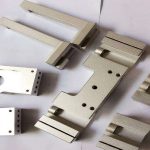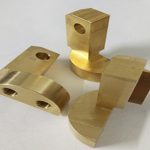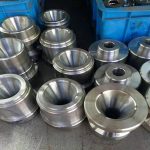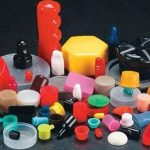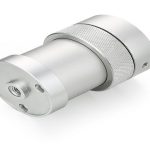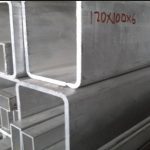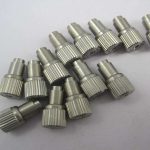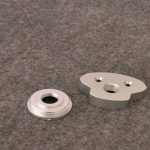A357 type (Al-Si-Mg) aluminum semi-solid casting material is known for its excellent strength and good ductility. It is the material of choice and is ideal in the manufacture of automotive mechanical moving parts.
Semi-solid casting is considered to be an effective technology for manufacturing automobile mechanical moving parts with superior quality, performance and efficiency. The lower control arm in the car suspension system is an important mechanical moving part responsible for connecting the car’s wheels with the chassis.
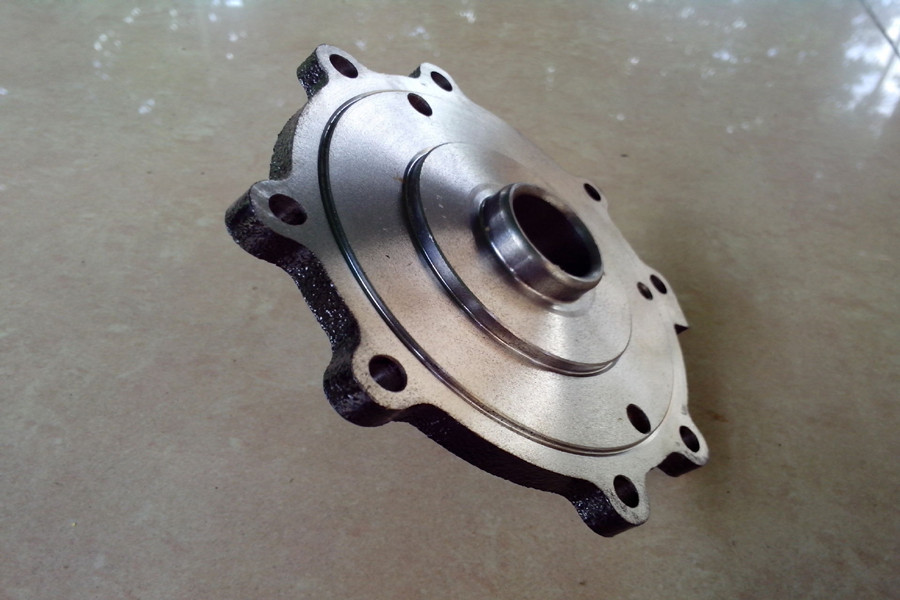
Because A357 aluminum alloy has light weight, high specific strength, and better corrosion resistance than steel, it has become a new trend to use A357 aluminum alloy to make this part. This research proposes different designs of suspension control arms developed, with regard to their strength-to-weight ratio. In addition, this study aims to explore the effect of accelerated thermal aging treatment on the fatigue life of A357 alloy bending fatigue specimens manufactured by rheological casting semi-solid technology.
The results show that compared with the standard thermal aging cycle, the multiple aging cycles of WC3 indicate that its fatigue life is better. On the other hand, compared with the traditional design, the proposed car suspension control component design shows a higher strength-to-weight ratio, better stress distribution and lower von Meese stress.
A357 aluminum (Al-Si-Mg) alloys are mostly known for their excellent strength and quality index values, and are widely used in various engineering fields, especially in the automotive industry. The automobile suspension system is an assembly of mechanical parts located between the automobile frame (chassis) and the road wheels. The suspension system is responsible for absorbing the impact from the road surface, keeping the vehicle tires in contact with the road surface, transmitting the applied power from the vehicle wheels to the chassis, and maintaining the normal kinematics of the suspension. Suspension systems usually consist of three main components: springs, shock absorbers and suspension linkages. Springs and shock absorbers are responsible for the response of the vehicle under random excitations under different road conditions (they are the objects of many automotive vibration studies), while the suspension linkage is a collection of mechanical components that connect the entire suspension system and transfer the force to Vehicle chassis. The use of light metals to make such mechanical parts helps improve vehicle performance by reducing unsprung mass. A number of studies have shown that the use of semi-solid casting technology to produce this aluminum alloy automotive suspension mechanical parts has superior mechanical properties.
Semi-solid forming (SSF) is a forming technology that combines casting, forming and extrusion processes. Apply mechanical or electromagnetic force to break the semi-solid structure in the mushy zone of the liquid-solid range. The temperature remains above the melting point during the entire process. It is then compressed into the mold cavity under high pressure to obtain the final geometry. Semi-solid is divided into two casting technologies: sulfur casting and rheological casting. Thixocasting refers to the formation of a desired green body with a desired microstructure through continuous casting, usually obtained by electromagnetic stirring. In rheological casting, the liquid metal is poured into a container of the same size as the mold to be filled, and then sent into the mold cavity, thus avoiding the reheating process of the stock metal. Semi-solid material (SSM) mixtures are produced and injected on demand, reducing the total cycle time, thereby reducing costs. Through cooling, grain refinement and stirring, the desired structure is obtained. Compared with the dendritic structure in traditional casting, the semi-solid casting process is characterized by the existence of equiaxed grain structure.
The main purpose of this research is to improve the fatigue life cycle of aluminum semi-solid materials through metallurgy and design parameters, and obtain high-quality automotive suspension mechanical parts. This study aims to explore the effect of accelerated thermal aging treatment with multiple cycles and intermittent cycles on the fatigue cycle of A357 (Al-Si-Mg) aluminum semi-solid alloy. In this work, modeling and finite element techniques are used to carry out design modification and stress analysis.
Material processing and programming
The standard samples and applicable parts are made of A357 aluminum alloy blank (Al-7%Si-0.65%Mg-0.1%Fe), which is prepared by rheological casting semi-solid process. The semi-solid casting process is matched with a high pressure die casting machine (HPDC) to produce materials for mechanical and microstructure characterization. Figure 1 shows the accelerated thermal aging treatment with multiple and intermittent cycles of T4/T6/T7. These heat aging treatments are applied to bending fatigue standard samples and applicable suspended mechanical parts. In this study, specific aging cycles were applied, mainly T6, WA0, WA1, WB0, WC1 and WC3. This is based on previous studies applied to A357 aluminum semi-solid alloys. They are positive for tensile and quality index characteristics. Influence. The bending fatigue samples were subjected to a two-step solution heat treatment, and then kept in water quenching at 60°C, and then naturally aged at room temperature for 24 hours, and then subjected to a thermal aging cycle.
The researchers used bending high-cycle fatigue test and tension-compression low-cycle fatigue test respectively to test the fatigue cycle and performance of standard bending fatigue samples of A357 semi-solid material and applicable suspension controls. In this study, a constant-flex cantilever bending fatigue test was used. The specimen is subjected to constant flexing under a high number of cycles until it breaks. After the bending fatigue specimen is installed, it must be fully restrained from one end, while the other end is connected to the rocker arm of the machine. The rocker arm was adjusted to maintain a constant stroke throughout the experiment, regardless of the load of each specimen. The machine used is a crank-slider mechanism, and the sample is connected to the slider part. 2a is the crank-slider mechanism representing the operating mechanism of the testing machine. The specimen is mounted at the slider position’S’, and the motor rotates the crank’R’ at a constant angular velocity’ω’. The stroke length is very important in this machine because it represents the deflection to be applied to the specimen. The stroke length can be changed by changing the length of the crank’R’. The fatigue testing machine used in this experiment uses an eccentric crank, where the eccentricity is the same as the length of the crank. Therefore, changing the eccentricity of the device will change the stroke length and the deflection imposed on the specimen. Figure 2b shows the eccentric crank, where the stroke can be adjusted from 0 to 2.0 inches (50.8 mm). The machine used works with a motor with a power of 0.5HP (373 watts), and the maximum force transmitted to the sample is 40 Ib (178 N). The operating frequency of all test samples was set to 12 Hz, and the deflection was 6.35 mm. As shown in Figure 2c, the sample is machined and then ground to remove any scratches caused by the processing. Scratches and macro cracks act as stress lifters to initiate fatigue cracks and cause a significant reduction in fatigue life. A MATLAB code is used to calculate the stress developed in the fatigue specimen. The Young’s modulus of aluminum is 70 GPa and the Poisson’s ratio of isotropic material is 0.33. The solid mechanics equation used in the stress calculation is as follows:
I = (bh^3)/12 & σ = my/I.
Among them,’I’ is the second moment of area,’b’ is the width of the sample,’h’ is the thickness of the sample,’σ’ is the stress,’m’ is the maximum bending moment, and’y’ is half of the thickness. 2d is the result graph of the code, showing that the maximum stress at the center of the reduced area is 50 MPa; then the stress gradually decreases, reaching zero near the constrained end and the free end. For suspension control components, under the condition of force control, use a servo hydraulic machine to perform a low-cycle fatigue test of sinusoidal force control at room temperature with a frequency of 1 Hz. The sinusoidal form of stress-compression load varies from ±105MPa to ±280MPa, and is controlled by applying a displacement ranging from ±1 to ±2mm.
Regarding the design procedure, the design parameters of the applicable parts must consider the stress distribution, the Von Mis stress value and the strength-to-weight ratio. The computer-aided design (CAD) software SolidWorks 2018 was used to modify the design of the suspension control arm and the finite element method. Abaqus Complete Abaqus Environment (CAE) 2018 finite element software package was used for finite element analysis (FEA). The finite element configuration of the applicable suspension control arm used in this study. The multi-point constrained (MPC) beam represents the most suitable loading condition, which should be most similar to the actual loading condition. To do this, it is necessary to fully understand the load imposed on the suspension control arm. The force acting on a vehicle tire can be calculated in three dimensions: x, y, and z; the x component is the longitudinal force (FLong), the y component is the lateral force (FLat), and the z component is the vertical force (FV). Although the vertical force is caused by the weight of the vehicle, and the lateral force is caused by the angle of inclination and toe angle, the important force in this study is the longitudinal force. It is caused by the rolling resistance force and the traction compression cycle caused by braking.
Design analysis and finite element
Automobile suspension control arm components are subjected to load forces applied in three directions. The longitudinal force can be calculated by the combination of rolling resistance and traction. The rolling resistance force can be calculated by multiplying the rolling friction coefficient’f’ with the vertical load of the vehicle. The traction force can be calculated by multiplying the instantaneous value, the friction coefficient’μ’, and the vertical load. The formula can be written as follows:
F_(long.) = (μ−f)*F_v
According to the understanding of the mechanical structure of the suspension, the finite element application of the design proposed in this study was carried out using Abaqus software, and the design was carried out through SolidWorks software. According to the applied force and specific design parameters, 4 designs with excellent performance were selected.
The first design, the inclined web with stiffening ribs, follows the inclined Z-shaped web instead of the traditional linear design. The web inclination angle is set to 7°, relative to the plane normal parallel to the upper flange, as shown in Figure 6a, to compensate for the 5° inclination angle of the ball socket. The choice of the inclination angle, after many trial and error, each time a different angle is used for finite element analysis and simulation. In the lower part of the control arm, small ribs are used to strengthen the structure to limit excessive deformation under load. It was found that the total mass of the part is 1198g, which is almost similar to the conventional design (1200g). The finite element analysis results of the inclined web design are shown in Figure 6. The maximum von Mises stress was found to be 213MPa, which was observed near the lower sleeve of the control arm. A maximum stress concentration factor (SCF) of 8 was observed near the lower bushing area. Under the action of a force of 5500N, the maximum deformation of the ball joint position is 1.45mm.
in conclusion
Regarding the fatigue cycle and design analysis of the accelerated thermal aging treatment of automotive suspension control components A357 aluminum semi-solid material, the following conclusions can be drawn:
1. The multiple accelerated thermal aging cycles of WC3 show a better actual part fatigue life improvement than standard T6. The number of cycles of C3 is 72,000, and the number of cycles of T6 is 36,000. The thermal aging cycle of WA0 also shows the enhancement of low-cycle fatigue life, reaching 40,000 cycles, which is considered to be more economical than T6;
2. The cantilever bending fatigue test shows that WC3 with accelerated thermal aging treatment has a superior life cycle, with an average of 82,000 cycles, while the average of T6 is 53,000 cycles. This proves the positive effect of multiple heat aging treatments of WC3 on the fatigue life. The aging cycle WA1 is also stronger than T6, with an average of 59,250 times; it is also considered more economical than T6;
3. The truss design of applicable components (Design 4) shows superior performance than all other designs proposed in this article-160gm lighter than the original design, the maximum VM stress is 198MPa, compared to the original design 232MPa. Design 4 is also more flexible than the original design, which can improve damping and significantly increase the life of the ball joint connected to the control arm. This flexibility is believed to better cushion road impacts, thereby improving suspension behavior and comfort;
4. Apply the selected WC3 multiple thermal aging treatment to the recommended design 4 (truss design), which is expected to withstand more than 84,300 cycles, that is, the life of the applicable parts is increased by 134%. This is calculated by calculating the stress value of the original design and the new design and the value of T6, compared with WC3.
Link to this article:
Reprint Statement: If there are no special instructions, all articles on this site are original. Please indicate the source for reprinting:https://www.cncmachiningptj.com
 PTJ® provides a full range of Custom Precision cnc machining china services.ISO 9001:2015 &AS-9100 certified.
PTJ® provides a full range of Custom Precision cnc machining china services.ISO 9001:2015 &AS-9100 certified.
Machining shop specializing in fabrication services for construction and transportation industries. Capabilities include plasma and oxy-fuel cutting, Tailored machining, MIG and Custom Aluminum Cnc Precision Milling Welding Jig Fixture, roll forming, assembly, Lathe machining stainless steel cnc machine shaft, shearing, and CNC Swiss Machining services. Materials handled include carbon and Passivation Stainless Steel Machining Cover Plate Parts.
Tell us a little about your project’s budget and expected delivery time. We will strategize with you to provide the most cost-effective services to help you reach your target,You are welcome to contact us directly ( [email protected] ) .
Link to this article:The new semi-solid casting material can be widely used in the manufacture of automobile mechanical parts!
Reprint Statement: If there are no special instructions, all articles on this site are original. Please indicate the source for reprinting:Tungusten,Thanks!^^

